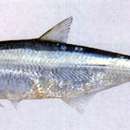Diagnostic Description
provided by Fishbase
Belly with 23 to 26 keeled scutes from isthmus to anus. Tip of snout above level of eye center, usually about level of upper rim of eye. Maxilla short or moderate; first supra-maxilla small, oval. A dark blotch behind upper part of gill opening.
- Recorder
- Crispina B. Binohlan
Diseases and Parasites
provided by Fishbase
Ascaridatosis (adult). Parasitic infestations (protozoa, worms, etc.)
Migration
provided by Fishbase
Amphidromous. Refers to fishes that regularly migrate between freshwater and the sea (in both directions), but not for the purpose of breeding, as in anadromous and catadromous species. Sub-division of diadromous. Migrations should be cyclical and predictable and cover more than 100 km.Characteristic elements in amphidromy are: reproduction in fresh water, passage to sea by newly hatched larvae, a period of feeding and growing at sea usually a few months long, return to fresh water of well-grown juveniles, a further period of feeding and growing in fresh water, followed by reproduction there (Ref. 82692).
- Recorder
- Crispina B. Binohlan
Morphology
provided by Fishbase
Dorsal spines (total): 0; Analspines: 0; Analsoft rays: 32 - 39
- Recorder
- Crispina B. Binohlan
Trophic Strategy
provided by Fishbase
Inhabits coral reefs (Ref. 58534). Presumably schooling, inshore and entering estuaries. More precise data needed, based on correct identifications (Ref. 43081). Juveniles and/or adults are found in mangrove creeks and inlets (Ref. 121464). If this is the species being referred to in Ref. 6841, then the principal food of the young would be prawns and copepods, supplemented by polychaetes and amphipods. Eggs, larval forms and juveniles occur in lower reaches of mangroves (Ref. 43081).
- Recorder
- Grace Tolentino Pablico
Biology
provided by Fishbase
Coastal pelagic (Ref. 68964). Presumably schooling, inshore and entering estuaries. More precise data needed, based on correct identifications. If this is the species being referred to in Ref. 6841, then the principal food of the young would be prawns and copepods, supplemented by polychaetes and amphipods.
- Recorder
- Crispina B. Binohlan
Importance
provided by Fishbase
fisheries: commercial
- Recorder
- Crispina B. Binohlan
Comprehensive Description
provided by Smithsonian Contributions to Zoology
Thryssa hamiltoni Gray, 1834
USNM 217037, Fly 75–32, 14: 26.9–47.8 mm (2 to BMNH).
This species was kindly identified by T. Wongratana. The specimens have maxillary bone extending posteriorly beyond opercle; the total number of anal fin rays 38–42; complete vertebral centra 43(1), 44(12), 45(1). The 47.8-mm specimen has 9+14 gill rakers on anterior face of first gill arch. The humeral pigment blotch characteristic of adult T. hamiltoni is not developed in these juveniles.
- bibliographic citation
- Roberts, Tyson R. 1978. "An ichthyological survey of the Fly River in Papua New Guinea with descriptions of new species." Smithsonian Contributions to Zoology. 1-72. https://doi.org/10.5479/si.00810282.281
分布
provided by The Fish Database of Taiwan
分布於印度-西太平洋(30°N~20°S)海域。西起印度、緬甸、安達曼海,東至臺灣,南至阿拉夫拉海。臺灣主要在西部、南部、北部及澎湖沿海。
利用
provided by The Fish Database of Taiwan
主要漁法為焚寄網、底拖網及流刺網,全年可產,西部沿海產量較豐,體薄肉少,通常曬成魚乾出售,或製成魚粉作為飼料之原料。
描述
provided by The Fish Database of Taiwan
體甚側扁,腹部在腹鰭前後均有一排銳利的稜鱗,腹鰭前16-19個,腹鰭後8-9個,共約23-26個。頭略小,側扁。吻鈍,吻長明顯短於眼徑。口大傾斜;上頜骨末端尖但略短,達主鰓蓋骨末緣或僅超出一些;第一鰓弓下枝鰓耙數11-15。體被圓鱗,鱗中大,易脫落,無側線;背鰭前方具1小棘,胸、腹鰭具腋鱗。背鰭起始於體中部,具12軟條;臀鰭長,具34-37分枝之軟條;尾鰭叉形。體背部青灰色,具暗灰色帶,側面銀白色;鰓蓋後上角具一黃綠色斑駁。背鰭、胸鰭及尾鰭黃色或淡黃色;腹鰭及臀鰭淡色。
棲地
provided by The Fish Database of Taiwan
沿近海表層魚類,濾食性,以浮游動物為主,輔以多毛類、端腳類。亦常可於河口區發現。
Thryssa hamiltonii
provided by wikipedia EN
- license
- cc-by-sa-3.0
- copyright
- Wikipedia authors and editors
Thryssa hamiltonii: Brief Summary
provided by wikipedia EN
Thryssa hamiltonii, or Hamilton's thryssa, is a species of ray-finned fish in the family Engraulidae. It is found in the tropical western Indo-Pacific region: mainly, the eastern direction near Myanmar, Taiwan, the northern head of Australia and Papua New Guinea and possibly the Philippines.
- license
- cc-by-sa-3.0
- copyright
- Wikipedia authors and editors

